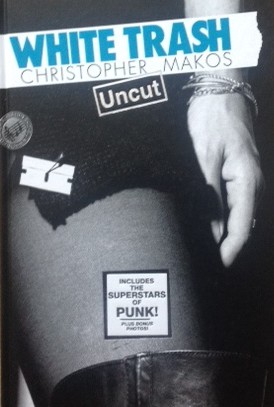Inspiring Older Readers
 posted on 02 Apr 2017
posted on 02 Apr 2017
White Trash – Uncut by Christopher Makos
The counter-cultural earthquake of the second half of the 1970s that the term ‘punk’ has come to define rarely attracts commentary on just how different the phenomenon was on either side of the Atlantic. Historically it is certainly the case that American punk was bubbling away for a couple of years before the British version broke cover and the impact on UK punk of Malcolm McLaren and Vivian Westwood’s flirtation with the New York musical underground scene is now well documented.
British punk was certainly more political, with a small and a big ‘p’, and was also rooted in the specifics of the British class system which gave it both a sharper edge and, for the establishment at least, a more dangerous one. The American version by contrast was much more about personal politics, the development of a youth-based ‘up yours’ attitude that rejected the stifling uniformity of the mainstream of US culture.
Christopher Makos is a US photographer who was one of the first to try and capture that sense of US, New York-based anti-establishment punk attitude. During the years of 1976-77 Makos accumulated a series of superb black and white photographs that he felt could be brought together in a single volume to be called White Trash. He handed the collection over to Fred Meyer, the art director at the book’s publisher, Stonehill. Makos was unhappy with the way his images were ‘punked-up’ by rough-cutting the images and setting them in what he saw as a punky format.
37 years later in 2014 Makos returned to the project, reclaimed the original framing, discarded the over-artful setting and added some extra photographs. The additions might look a bit puzzling – what has Jagger or Bowie got to do with punk you might well ask. Well, I think this is a good illustration of what I was saying about the difference between British and US punk – for the Americans it’s all about attitude and clearly Makos thinks Jagger and Bowie have it.
I really do love the quality of these photographs, they glow off the page and the best of them really do define a moment in time. Characters like Tom Verlaine and Richard Hell look like they embody a new generation and a new set of attitudes waiting to sweep away the old guard. Debbie Harry, as always, is achingly photogenic and the weirdness of Devine and John Walters give us a glimpse of the alternative cinema that would move into the mainstream.
Punk is essentially an urban scream and if you understand that sound you’ll respond to these photographs with a knowing nod of the head because, seemingly counter-intuitively, photography rather than music is very often the art form that best captures what this youth movement was all about. Copies of this upgraded uncut reprint are not too hard to find on the second hand market and you’ll pay less than £20 to get one.
Terry Potter
April 2017